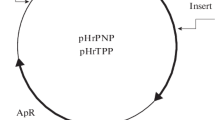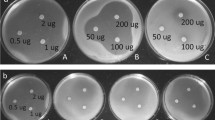Abstract
1. Actinomycin-D inhibits the synthesis of benzoic acid oxydase in growingM. friburgensis cells only after a longer incubationperiod. The inhibition in resting cells is markedly lower. It is doubtful that ribonucleic acids with a high metabolic activity have an important role in the synthesis of benzoic acid oxydase; Actinomycin inhibited the synthesis of pulselabeled RNA significantly stronger than the synthesis of benzoic acid oxydase ofM. friburgensis cells.
2. Experiments with C14-labeled benzoic acid — using ring-labeled and 7-C14-labeled benzoic acids — showed that preincubation of theM. friburgensis cells with Actinomycin increased the penetration of the benzoic acid into the bacterial cells. At the same time this preincubation inhibited also the synthesis of benzoic acid oxydase — although on a law rate —, therefore no direct relation between the transport of benzoic acid into the cells and the synthesis of benzoic acid oxydase could be stated.
3. After 10 min preincubation ofM. friburgensis cells with Actinomycin-D, benzoic acid can be shown bound to the 660 g cell fraction. This binding is strongly inhibited by Actinomycin-D.
Zusammenfassung
1. Die Benzoesäureoxydase-Synthese vonM. friburgensis, das sich in Vermehrung befindet, wird durch Actinomycin-D erst nach längerer Inkubation gehemmt. Die Hemmung ist an ruhenden (resting) Zellen wesentlich geringer. Es wird bestritten, daß die schnell markierbaren Ribonukleinsäuren an der Benzoesäureoxydase-Synthese eine Schlüsselrolle spielen, da die Synthese der pulsationsmarkierbaren RNS durch Actinomycin wesentlich stärker gehemmt wird, als die Benzoesäureoxydase-Synthese derM. friburgensis-Zellen.
2. Versuche mit C14-markierter Benzoesäure — teils am Ring, teils an der Carboxylgruppe markiert — führten zum Schluß, daß das Eindringen der Benzoesäure in die Bakterienzellen durch Präinkubation mit Actinomycin-D gefördert wird. Zugleich wird die Benzoesäureoxydase-Synthese durch diese Präinkubation — wenngleich in geringem Maße — gehemmt, folglich kann kein unmittelbarer Zusammenhang zwischen Benzoesäure-Transport in die Zelle und der Benzoesäureoxydase-Synthese bestehen.
3. Nach einer 10 min langen Präinkubation derM. friburgensis-Zellen mit Actinomycin-D ist die Benzoesäure an der Zellfraktion von 660 g gebunden. Das Zustandekommen dieser Bindung wird durch Actinomycin-D stark gehemmt.
Similar content being viewed by others
Author information
Authors and Affiliations
Rights and permissions
About this article
Cite this article
Földes, I., Tomcsányi, A. Induktive Benzoesäureoxydase-Bildung bei Mycobacterium friburgensis. Pneumologie 142, 210–216 (1970). https://doi.org/10.1007/BF02095218
Issue Date:
DOI: https://doi.org/10.1007/BF02095218




